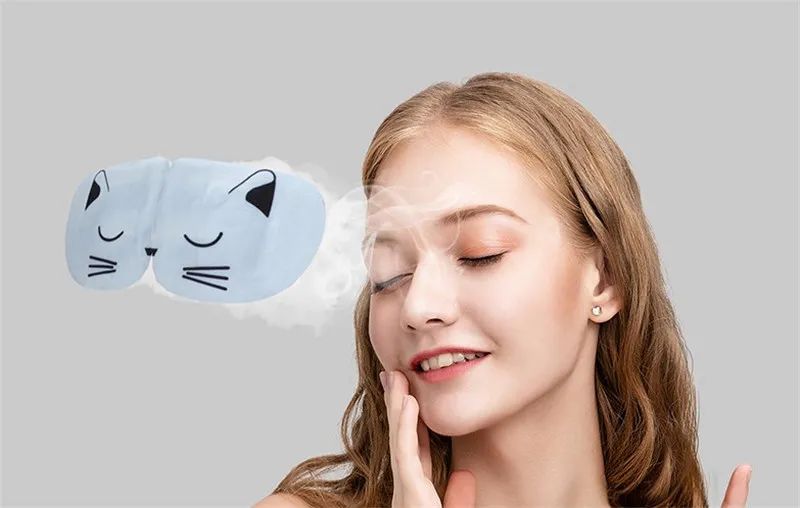I. Basics
What is a steam eye mask?
A: A disposable, self-heating eye mask. When worn, internal heating materials (usually iron powder, activated charcoal, etc.) react with oxygen in the air to produce gentle steam (approx. 40°C/104°F) and heat, lasting about 15-30 minutes.How does a steam eye mask work?
A: Utilizes the oxidation-reduction reaction (rusting principle) of a mixture like iron powder, activated charcoal, water, and salt to generate heat, evaporating contained water to produce warm steam.Does it really produce “steam”?
A: Yes, moisture in the heating element evaporates, creating a warm, humid micro-environment inside the sealed mask, feeling like steam.What temperature do they reach?
A: Typically around 40°C (104°F), slightly above body temperature, feeling comfortably warm and safe (from reputable brands).How long do they stay warm?
A: Most products last 15-30 minutes, varying by brand and formulation.Are steam eye masks disposable?
A: The vast majority on the market are single-use.What are the main components?
A: Heating element: Iron powder, activated charcoal, salt, water, vermiculite. Outer layer: Non-woven fabric. Fragrance (optional). Elastic ear loops.Why do they start heating as soon as the package is opened?
A: Exposure to air triggers the oxidation reaction of the iron powder. Use promptly after opening.Do they have a smell?
A: Unscented and various scented options (e.g., Lavender, Chamomile, Rose, Yuzu) are available. Unscented has little to no smell.
II. Benefits & Effects
What are the main benefits?
A: Core benefits are relieving eye strain (asthenopia) and dryness, and aiding relaxation and sleep.Do they reduce dark circles?
A: Limited effect. Warmth may improve circulation, helping vascular dark circles slightly, but ineffective for pigmented or structural types.Do they remove eye bags?
A: No. Warmth may temporarily reduce puffy bags, but it’s immediate and temporary, not a cure.Do they treat dry eye syndrome?
A: They do not “treat” it. They alleviate discomfort (dryness, fatigue) by warming and moisturizing the eye surface, but cannot replace artificial tears or professional treatment. Consult a doctor for severe dry eye.Do they treat myopia (nearsightedness)?
A: Absolutely not. They have no effect on preventing or treating myopia.Are they effective for eye strain?
A: Yes, it’s a primary benefit. Warmth relaxes tense eye muscles and improves circulation, effectively relieving strain symptoms (soreness, dryness, blurriness) from prolonged screen/reading use.Do they help with sleep?
A: Yes, significantly. Warmth promotes relaxation. Combined with darkness and optional calming scents (e.g., Lavender), they create a good sleep environment, often used before bed.Do they reduce fine lines?
A: Minimal effect. Warmth may temporarily hydrate skin, making lines look less visible, but doesn’t boost collagen or eliminate wrinkles.Do they enhance eye cream absorption?
A: Somewhat. Warmth boosts circulation, potentially aiding absorption slightly, but not dramatically. Apply eye cream after using the mask.Can they be used for eye heat therapy?
A: They are a convenient form of eye heat therapy. More consistent, convenient, and hygienic than a warm towel.
III. Who Can Use & Precautions
Who benefits most?
A: People with prolonged eye use (office workers, students), poor sleepers, those experiencing eye dryness/fatigue, and long-distance travelers.Can children use them?
A: Use cautiously. Choose child-specific masks with lower temperatures and supervise. Generally not recommended for very young children (e.g., preschool). Check product instructions.Can pregnant women use them?
A: Generally yes. Choose unscented/mildly scented, simple-ingredient products from reputable brands. If sensitive or having strong pregnancy reactions, consult a doctor. Avoid abdominal use.Can they be used during menstruation?
A: Yes. No impact on eye relaxation.Can they be used after refractive surgery (e.g., LASIK, SMILE, ICL)?
A: Absolutely forbidden in the short term post-op (usually 1-3+ months)! Strictly follow doctor’s orders. Only consider use after full recovery and doctor approval, with extreme caution.Can they be used with eye inflammation (e.g., conjunctivitis, stye, keratitis)?
A: No! Heat can worsen inflammation and redness. Wait until fully healed.Can they be used after other eye surgery or injury?
A: No! Follow doctor’s advice; prohibited during recovery.Can they be worn over contact lenses?
A: Absolutely not! Remove contacts first. Only consider reinserting lenses after use and when eyes feel completely comfortable.Can people with eye diseases (e.g., glaucoma, severe dry eye, eyelid disorders) use them?
A: Always consult an ophthalmologist first! Heat may be unsuitable for some conditions.Can people allergic to mask materials use them?
A: No. Avoid if allergic to non-woven fabric, fragrances, or heating materials.Can they be used during a fever?
A: Not recommended. Adding heat to the head while febrile may cause discomfort.
IV. Usage
How to wear them correctly?
A: Open package, unfold mask, hook elastic loops over ears, adjust for comfortable coverage over closed eyes. Lying down or reclining is most comfortable.When is the best time to use them?
A: Before sleep (to aid sleep), during naps, after prolonged eye use (relieve strain), during long travel, or when eyes feel dry/uncomfortable.How many times per day can they be used?
A: Generally 1-2 times daily, with breaks between uses. Overuse may dry skin or create dependency. Adjust based on comfort.How long per use?
A: Remove once heating stops (15-30 mins). No need to extend.Can eyes be open while wearing?
A: Not recommended. Steam and warmth are designed for closed eyes. Opening eyes may cause discomfort, dryness, or irritation. Always use with eyes closed!Do eyes need rinsing after use?
A: No. Open eyes normally to adjust to light. If slightly moist, blink or gently dab the area with a clean tissue.Can phones/computers be used immediately after?
A: Not advised. Staring at screens right after relaxation counteracts the benefit. Rest with eyes closed or sleep.Can they be worn overnight?
A: Strongly discouraged! Though heat lasts ~30 mins, sleeping with it on may cause pressure, discomfort, or hazards (e.g., tangling). Remove after heating stops.What does it feel like?
A: Warm, moist, relaxing comfort. Slight pressure is normal. Stop immediately if stinging or burning occurs.What if it feels too hot during use?
A: Remove immediately! Could indicate product issue or sensitivity. Stop using and let eyes rest. Choose a cooler brand.
V. Safety & Cautions
Are they safe?
A: Generally safe for most people when using reputable, quality products correctly (remove contacts, eyes closed, not overnight).Can they burn eyes or skin?
A: Reputable products control temperature safely (~40°C), usually not. Risk exists with faulty products, misuse (e.g., with contacts, damaged), or sensitive skin. Remove if uncomfortable.Can they cause allergies?
A: Possible. Allergens could be fragrances, fabric, or heating materials. Test new brands/scents cautiously. Choose unscented if prone to allergies.Do they accelerate skin aging?
A: Normal use doesn’t. Skin may feel dry afterward; apply eye cream to moisturize.Why blurred vision after use?
A: Usually temporary. Steam may increase moisture on the cornea or alter the tear film. Blinking or resting resolves it. Persistent blur needs medical attention.Are they addictive?
A: Not physically. Psychological reliance on the relaxation feeling is possible. Use reasonably.How to know if a mask is usable?
A: Disposable – discard after single use. Check expiration date on unopened packages.Can expired masks be used?
A: Not recommended. Heating materials may fail or overheat; fabric may degrade. Safety risk.Can damaged packaging masks be used?
A: Do not use! Damage risks leakage or overheating, increasing burn risk.What happens if they get wet?
A: Avoid water. Water on unused masks may trigger reaction or deactivate it. Water during use affects heating or causes discomfort.
VI. Buying Guide
How to choose?
A: Consider temperature, heat duration, scent preference, comfort (ear loops, fabric), brand reputation, price. Start with unscented basics.Unscented vs. Scented: Which is better?
A: Personal preference. Unscented suits sensitive users or public spaces. Scented offers added relaxation/sleep benefits.What do different scents do?
A: Lavender (classic sleep/relax), Chamomile (soothing), Rose (uplifting), Citrus/Yuzu (refreshing), Unscented (pure heat). Choose based on mood/need.Popular brands?
A: Kao (Japan, pioneer), Zhen Shi Ming, Yunnan Baiyao, Shining, Xuancao, Ru Mu, MINISO house brands, etc.Difference between expensive & cheap?
A: Differences may be: heating tech (consistency), fabric comfort, scent quality, brand premium, packaging. Core principle is the same. Choose reputable brands with good value.Need “extra benefit” masks (e.g., with oils/herbs)?
A: Be skeptical. Core value is physical heat. Skin absorption of additives is limited. Basic or scented versions are usually sufficient. Ensure additive safety.Single-pack vs. Multi-pack?
A: Multi-packs (e.g., 5, 10, 14) are more economical for regular use. Singles are for sampling or travel.What info to check when buying?
A: Brand, manufacture/expiry date, ingredients (especially fragrances), intended users, contraindications, instructions, safety marks.Where to buy reliably?
A: Large supermarkets, reputable pharmacies, brand official stores (Tmall, JD.com), major e-commerce platforms. Avoid unknown sellers.Typical price per mask?
A: Varies widely, generally 1-5 RMB per mask. Imported brands (e.g., Kao) cost more; domestic brands offer better value.
VII. Special Situations
Can they be used on airplanes?
A: Ideal! Relieves dryness, blocks light for sleep, reduces travel fatigue.On trains/long bus rides?
A: Yes, also aids rest. Secure belongings.During office naps?
A: Yes, great for relaxation. Choose unscented/mild scents for courtesy.In air-conditioned rooms?
A: Yes, helps combat AC dryness.Winter vs. Summer use?
A: Winter feels cozier. In hot summers, may feel stuffy; choose cooler/shorter-duration masks or use in AC.Need to turn off lights?
A: Recommended for dark/dim environments. Darkness aids relaxation/sleep. Many masks block light well.Can they be reused?
A: Most cannot. Heating reaction is single-use. Rechargeable electric steam masks are a different product category.Steam mask vs. Warm towel?
A: Steam mask pros: Consistent temp, convenient, hygienic (disposable), hands-free, blocks light. Towel pros: Cheaper, controllable temp (needs refreshing), potential for herbs (with guidance). Steam masks are more convenient.
VIII. Other Questions
What’s inside? Black powder?
A: Heating materials – iron powder, activated charcoal, etc. Safe. Do not use if leaking.Is moisture inside after use normal?
A: Small condensation is normal (steam cooling). Excessive wetness may indicate a problem or very humid environment.Can you do other activities while wearing?
A: Not recommended. Best used while resting with eyes closed. Walking/activity risks distraction, tripping, or poor fit.Effective for insomnia?
A: Helpful as an aid. Relaxation and darkness promote sleep onset, but not a replacement for insomnia treatment.Can you do eye exercises while wearing?
A: No. Exercises require open eyes and massage; masks require closed eyes and coverage. Incompatible.Do they treat headaches?
A: May relieve headaches caused by eye strain/tension (via muscle relaxation). Effectiveness for other types is unclear.Can they be worn over glasses?
A: Remove glasses first. Masks go directly on the skin.Need eye cream after use?
A: Recommended. Warmth may increase moisture loss; cream helps hydrate.Difference vs. cold eye masks?
A: Opposite effects. Steam masks (heat) relax, relieve fatigue/dryness, aid sleep. Cold masks reduce puffiness (crying, morning), acute inflammation, or allergic redness/itching.Electric reusable vs. Disposable: Which is better?
A: Disposable: Convenient, hygienic, portable, no charging. Electric: Reusable, adjustable temp/time, potentially more eco-friendly long-term. Choose based on needs.Can they be taken on planes?
A: Yes. Not prohibited. Allowed in carry-on or checked luggage domestically and internationally.Are they a scam (“IQ tax”)?
A: For core benefits (relieve eye fatigue/dryness, relax/aid sleep), no, the principle is sound and experience supports it. Be skeptical of exaggerated claims (e.g., remove bags, treat myopia).
IX. Fun Facts
First brand? A: Kao (Japan) “MegRhythm” was the pioneer.
Most popular scent? A: Lavender is usually the classic favorite.
Are there men’s versions? A: Not strictly. Men can choose unscented or preferred scents.
Can they be used on other body parts? A: Not recommended. Designed for eyes. Use specific products (e.g., shoulder/neck patches, heat packs).
Can you DIY one? A: Not recommended & unsafe. Hard to control temp, moisture, and hygiene; burn/infection risk.
Why do some people find them useless? A: Individual differences (insensitivity), unrealistic expectations, poor quality products, incorrect use (eyes open, contacts in).
Do they make noise while heating? A: Usually silent or very faint rustling (reaction sound), not bothersome.
How to dispose? A: Dispose as residual/dry waste (spent materials inert). Recycle packaging per material.
Is collecting different scents/designs worthwhile? A: Personal hobby, like collecting anything. Mind the expiry date.
Are they good gifts? A: Excellent! Practical and thoughtful for people who strain their eyes, have sleep issues, or travel often. Gift boxes are nice.
X. Additional Notes
“Thin-sheet” vs. Traditional “Pouch” type?
A: Thin-sheet: Lighter, thinner, less pressure, heats faster/more evenly, more comfortable. Pouch: Often thicker. Thin-sheet is a growing trend.How to judge heating uniformity?
A: Feels evenly warm around the eye area, no hot/cold spots. Good products heat uniformly.Sensitive to scents but want sleep aid?
A: Choose unscented. Warmth and darkness themselves are highly relaxing/sleep-inducing.More red veins after use? Normal?
A: Temporary slight increase is normal (improved circulation), fades with rest. Stop and see a doctor if severe/continuous redness or pain.Can they be used right after eye drops?
A: Best to wait 10-15 minutes. Avoid diluting drops or steam affecting efficacy. Follow drop instructions/doctor’s advice.Can they be used after eye treatments (e.g., laser, facials)?
A: Not in the short term post-procedure! Strictly follow post-care instructions from the provider; heat is usually prohibited during recovery (days/weeks).Can they be used on damaged/eczema skin around eyes?
A: No. Avoid irritating wounds or worsening eczema.Can they be used with high eye pressure?
A: No! Heat may increase intraocular pressure. Contraindicated for glaucoma or suspected high pressure. Consult a doctor.Difference vs. regular sleep masks?
A: Key difference: Steam masks heat + produce steam + block light; regular sleep masks only block light. Different purposes.Does this Q&A cover everything?
A: Aims to cover most common questions! Feel free to ask about anything else.
Important Reminder: Steam eye masks are supplementary for comfort, not medical treatment. Consult a doctor for persistent or serious eye issues.



